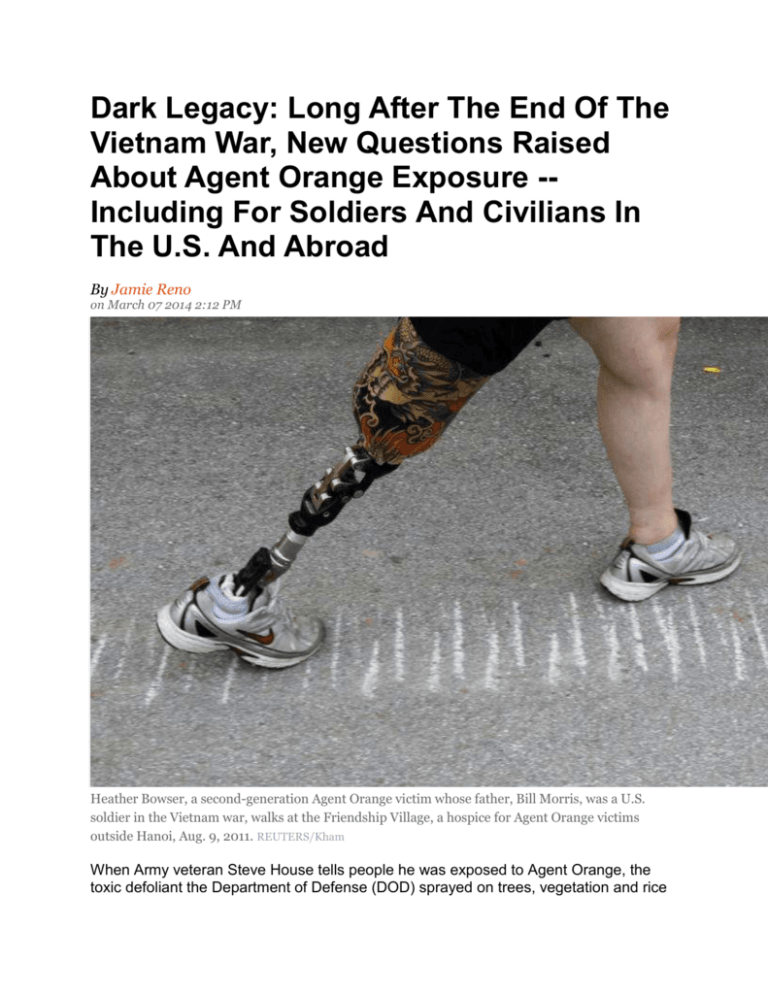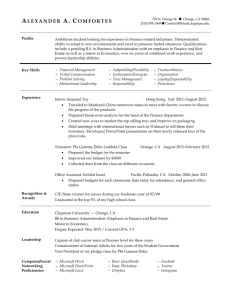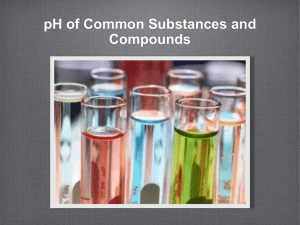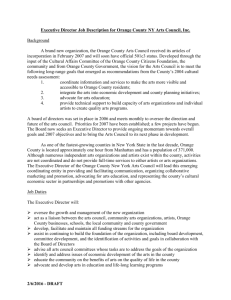Dark Legacy
advertisement

Dark Legacy: Long After The End Of The Vietnam War, New Questions Raised About Agent Orange Exposure -Including For Soldiers And Civilians In The U.S. And Abroad By Jamie Reno on March 07 2014 2:12 PM Heather Bowser, a second-generation Agent Orange victim whose father, Bill Morris, was a U.S. soldier in the Vietnam war, walks at the Friendship Village, a hospice for Agent Orange victims outside Hanoi, Aug. 9, 2011. REUTERS/Kham When Army veteran Steve House tells people he was exposed to Agent Orange, the toxic defoliant the Department of Defense (DOD) sprayed on trees, vegetation and rice fields during the Vietnam War, the first thing he’s typically asked is where he was stationed in that country. But House has never been to Vietnam. He didn’t join the military until three years after the last American troops evacuated Saigon. In 1978, House, now 56, was an E-4 specialist and bulldozer operator with D Company 802nd engineers at Camp Carroll, a U.S. Army base in South Korea, where House said he and four fellow soldiers were ordered to dig an enormous trench on the base, then bury 250 barrels of Agent Orange. In separate, exclusive interviews, former soldiers House, Bob Travis and Richard Kramer each told IBTimes how their postwar exposure to the harmful agent has had a profoundly negative effect on their lives and that the DOD and the Department of Veterans Affairs (VA) continue to call them liars. "They didn't tell me what we were burying, but on the side of the 55-gallon barrels it said in bright yellow and bright orange letters, 'Province of Vietnam, Compound Orange’,” House said. “We knew that stuff was bad, and I had a lot of guilt about what I’d done to the people in Korea. I also felt really betrayed by my own government and the country that I love. " Travis, an Army private first class and one of the two truck drivers who dumped the Agent Orange along with House, said he didn’t know much about Agent Orange at the time, “but our sergeant, who’d been in Vietnam, told us this was the stuff he had sprayed on the trees. We just did what we were told. It isn’t right that the government keeps lying about what happened at Camp Carroll.” The widespread use of Agent Orange in Vietnam was a dark chapter in U.S. military history that proved devastating for countless Vietnamese civilians as well as hundreds of thousands of American troops. After decades of denial, VA in the early 1990s first started acknowledging the direct scientific links between exposure to the herbicide and a variety of cancers as well as Parkinson's disease, diabetes, birth defects and more. But the government has never talked much about the allegedly harmful ways in which DOD stored, tested and then disposed of Agent Orange on U.S. military bases across the globe before, during and after the war. The VA still consistently denies claims from veterans like House who say they were exposed after the war but can’t empirically prove it. And in 2009, the Supreme Court made it impossible for any veteran to sue Monsanto Co. and Dow Chemical Co., makers of Agent Orange. Without comment, the justices declined to review a 2008 ruling by a U.S. appeals court that the veteran plaintiffs could not pursue their claims for their alleged injuries from their exposure to the defoliant. “No one’s accountable,” said House. “Not DOD, VA, politicians or the courts. Everybody’s running from the liability.” But the paradigm for veterans exposed to Agent Orange after the Vietnam War may be about to change in their favor. A study published last week in Environmental Research found that airmen who flew and maintained the C-123 Provider aircraft long after the planes were used to spray Agent Orange over Vietnam were exposed to dangerous levels of the dioxin that remained in the aircraft. The American Legion, the nation’s largest veterans organization, responded to this news last week with a new call for VA to extend disability compensation benefits to former C-123 aircrews. “I believe this new study will blow a big hole in the DOD and VA’s story,” House said. “Now there’s proof that vets were exposed well after the Vietnam War. But the C-123s are just the tip of the iceberg.” What Happened at Camp Carroll? For nearly a decade, House, who lives in Algonac, Mich., 45 miles north of Detroit, has been fighting VA to get coverage for his multiple illnesses, which several doctors including two from VA have said, in writing, were caused by his Agent Orange exposure at Camp Carroll. House suffers from an enlarged liver, failing pancreas, and other problems that have all been scientifically linked to Agent Orange. Despite his worsening condition and inability to work, House was given just a 30 percent disability rating by VA for Post-Traumatic Stress (PTSD), which is not related to his exposure. The Army now admits that toxic chemicals were dumped in that large ditch in 1978, though officials insist that Agent Orange wasn’t one of them. After House first went public with his story to an Arizona TV station in May 2011, a joint U.S.-South Korean investigation team reportedly spent as much as $4 million looking into his claims. Col. Joseph Birchmeier, head of that investigation, said at a 2012 press conference that he was “99.9 percent confident” that Agent Orange was never buried there. But he also said it is possible that the toxic chemical may have been buried there and removed without leaving a trace for investigators to find years later. The investigation did reveal that other herbicides, pesticides, solvents and chemicals were buried where House said he buried the Agent Orange. In 2011, groundwater testing at the base reportedly found trace amounts of 2,4,5-T – an herbicide that is a component of Agent Orange. “We’re telling the truth,” House said. “Bob [Travis] saw the barrels first, then came up to me and said, ‘I don’t have a good feeling about this. They have a whole damn warehouse of Agent Orange’.” "They Wanted to Put Me in a Straitjacket” Richard Kramer, the bucket-loader operator who worked with House, Travis and others at the Carroll dump site, said that after just a few days on this toxic job, he started to experience numbness in his feet. His health degenerated from there. "My condition got so bad that in a few weeks I became paralyzed from the waist down," Kramer said. "I was medevaced to Seoul and from there was transported to Walter Reed Army Hospital, where I stayed for the next two and a half months. They could not find what was wrong with me. I was diagnosed with Reiters' Syndrome, which they also call reactive arthritis. They never took care of me. There was no follow-up. I've had this in my body all these years. I am 50 percent disabled now. But I can't work. I have no doubt that this was because of my exposure to Agent Orange." When Kramer went looking for his medical records, he said some of them were missing or blacked out. “I called Walter Reed at one point and they had no evidence of me being there whatsoever," Kramer said. “The contents of the barrels housing the Agent Orange were eating right through the drums. Within a couple weeks, I had a rash all over my body, and I still have it to this day. But when I went to Walter Reed and told them about this, they wanted to put me in a straitjacket. They said I was a psycho." Kramer got the worst of it at Camp Carroll, according to Travis. "Our sergeant didn't like Kramer because he was a hippie who parted his hair in the middle," Travis recalled. "That's why he made Kramer stand at the bottom of the hole." Travis said his exposure to Agent Orange in Korea ruined his military career. But he added, “I got involved in this not because of me but because my buddy Steve has a liver the size of a basketball. He needs help. It isn’t right.” The VA’s Side of the Story When asked to respond to House’s assertion that he is being unfairly denied his disability claim, a VA spokesperson said that despite his doctors’ declarations, House has not proven his exposure. “The physical diseases that he claims are related to Agent Orange exposure are also diagnosed in a large portion of the American public who were never in the military,” said the spokesperson. “Being diagnosed with a disease that VA associates with Agent Orange exposure is not evidence that it resulted from such exposure.” The VA spokesman acknowledged that Agent Orange was used in the Korean DMZ during 1968-69 but said the agency does not support House’s claim of exposure. “Camp Carroll was not located on the DMZ and would not need the security measures of Agent Orange perimeter defoliation to prevent enemy infiltration,” said the spokesperson. “Camp Carroll was not on an Agent Orange supply route and therefore storage or transportation there would have been unlikely.” VA sent a request to DOD’s Army and Joint Services Records Research Center for information on the alleged digging of a trench and burial of 55-gallon drums in 1978 by the Veterans 802nd Engineer Battalion. The VA spokesperson said the response showed that “a 1978 digging construction project was done for an oil storage area. This evidence does not support a disability claim based on Agent Orange exposure.” The VA spokesperson concluded, “There was no active use of Agent Orange after its Vietnam termination in 1971. However, remaining supplies were transported to Johnston Island in the Pacific Ocean for incineration at sea, which occurred in 1977, after the Vietnam War. VA has acknowledged exposure for several veterans based on evidence that they handled active Agent Orange during the post-Vietnam Johnston Island incineration process.” A VA spokesperson also said that due to the consideration of possible long-term adverse health effects from potential exposure Agent Orange in C-123 aircraft crewmembers post-Vietnam, VA has formally asked the National Academy of Sciences, Institute of Medicine to study the issue and report back to the department. Rick Weidman, executive director for policy and government affairs at Vietnam Veterans of America, said that many veterans like House were exposed to Agent Orange after the Vietnam War – and not just on Johnston Island. “Everything Steve has shared with us about his experience in Korea is credible and authentic,” Weidman said. “He is telling the truth. He has the documentation, a lot of it.” The DOD’s Position According to Stars and Stripes, military records show that a large number of chemical barrels were buried at Carroll in 1978 but were dug up and shipped out the following year. The records did not specify what the barrels contained or where they were taken, though military officials told the military news publication that they were possibly shipped to a Utah depot for storage. Since House went public three years ago, he's hired an Army archives expert to track down just where the barrels were shipped, and that researcher discovered that the Merchant Marine ship that was contracted to carry the toxic cargo was intercepted in the waters off San Francisco and the ship’s crew and the Army were fined. House said the researcher told him a Coast Guard library document explaining the detainment had been checked out during the U.S.-Korea investigation of House’s charges and was “never returned.” A DOD spokesman told IBTimes the agency had no knowledge of this incident. House said he also unearthed two land surveys of Camp Carroll, one done in 1982 and another in 1992, both concluding that the drinking wells at the base and around the perimeter outside of the base were contaminated, and that the DOD never told the Korean government about this until House first shared his story a few years ago. A spokesperson for DOD told IBTimes that during the Vietnam War, Agent Orange was shipped directly from Monsanto and Dow to Vietnam, and that whatever Agent Orange was not used was then shipped from Vietnam directly to Johnston Island, where it was incinerated. The spokesperson denied that any Agent Orange was ever stored or buried on a U.S. military base after the Vietnam War. But according to Weidman, “DOD has lied to us about this from the outset. We have reason to believe that Agent Orange was used and stored everywhere in the Pacific that we were, from Vietnam, Thailand and Laos to South Korea, Japan and Okinawa. We also believe it was used at virtually every place where we have a military base.” Toxic U.S. Military Bases House said his research shows that not only was Camp Carroll contaminated, but that most military bases in the United States have at least one Superfund site and that many of them tested, stored and buried Agent Orange before, during and after the Vietnam War. “Until 1982, DOD took the cheap and dangerous way out using the method of landfilling to get rid of these deadly chemicals that were weaponized for war,” he said. It’s been widely reported and documented that many of America’s military bases are toxic. Multiple reports suggest that Agent Orange was stored, used and buried during the war and afterward on U.S. bases everywhere from Guam and Okinawa to Fort Ord in California and Ford Detrick in Maryland, the so-called birthplace of Agent Orange where it was tested and some veterans were reportedly harmed. More than 1.4 million gallons of Agent Orange was reportedly brought to Okinawa from Vietnam before being taken to Johnston Island to be incinerated, according to this Army document. And the toxic legacy at Okinawa is still making news. Recently at the Kadena (U.S.) Airbase in Okinawa, highly toxic compounds were discovered at a dump site near two schools for children of U.S. military. Also, military records related to Agent Orange reportedly show an herbicide stockpile at Kadena in 1971. DOD denies that the toxins discovered recently at the base are Agent Orange, but parents at the base are demanding that more tests be done of the soil. Agent Orange was also allegedly exposed to veterans at Eglin Air Force base in Florida, where gallons of the defoliant were reportedly sprayed by the Air Force in the 1960s. Susan Hammond, a recognized expert on Agent Orange and executive director of War Legacies Project, said of the recent discovery in Okinawa, “Some of the barrels unearthed had traces of TCDD and 2,4,5-T, which are both are evidence of dioxin contaminated herbicides. The military said it wasn’t Agent Orange, but it doesn’t matter because the key thing is they found 2,4,5-T, an herbicide, and TCDD, which is found in dioxin-contaminated herbicides. Whether it was Agent Orange or some other agent is not as important as addressing the issue of dioxin found buried where children were playing up to a few years ago.” The most egregious example of toxic exposures to American troops on a U.S. military base and surrounding residents took place at Ft. McClellan, an Army compound in Alabama that was shut down in 1999 by the EPA. As Chicago Now reported last year, Monsanto settled a case a decade ago with more than 20,000 residents of Anniston, Ala., adjacent to the base, for $700 million after contaminating the water, soil and air with its chemicals. More than a decade ago, former Congressman Lane Evans (D-Ill.), who at the time was ranking Democrat on the House Veterans Affairs Committee, stated in a press release that Agent Orange was used and stored in as many as 30 military locations from Fort Gordon, Ga., to Kingston, R.I., and Brawley, Calif. The chemicals stored at Ft. McClellan, which include Agent Orange, sarin and mustard gas, have caused serious health problems for Anniston residents and soldiers stationed at the base -- everything from cancer to diabetes to spinal stenosis to multiple miscarriages to birth defects. However, while the massive settlement has helped the suffering town's residents, it excludes military personnel who were stationed at Ft. McClellan over the years. Never Wanted to Be a Hero House, who said he “never wanted to be a whistleblower or a hero,” just wants his claim approved. He wishes he could put that time at Camp Carroll behind him. It was a difficult transition for him after he left the Army. “I didn’t fit in any more,” he said. "Then I started to learn more about Agent Orange, and I began getting angry. Now I want to get the word out for my fellow veterans from that era who are dying off, every day. So many of them have never gotten the care and treatment they deserve." House said that if he or his Army buddies were lying about all this, "Why haven't we been brought up on charges? I just want my day in court. Let me prove this happened. If I’m ever given the chance to testify before a congressional hearing, I believe I could prove my case and expose the cover-up that is much bigger than what happened at Camp Carroll. The VA is stalling for time because they will not be able to handle the funding for such an enormous liability. They’re letting my appealed file gather dust and just waiting for me to die." Jamie Reno, an award-winning author and Newsweek correspondent for 20 years, has also written for the New York Times, The Daily Beast, Sports Illustrated, Rolling Stone, People, Los Angeles Times, Entertainment Weekly and USA Today.



